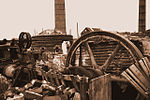Ashby Woulds
Civil parishes in LeicestershireDistricts of England abolished by the Local Government Act 1972Leicestershire geography stubsNorth West Leicestershire DistrictUse British English from July 2015

Ashby Woulds is a civil parish in Leicestershire, England. The population (including Albert Village) at the 2011 census was 3,763. It is in the North West Leicestershire district, to the west of Ashby de la Zouch. The main settlements in the parish are Moira and Norris Hill. Until 1974 the parish was an urban district of Leicestershire.
Excerpt from the Wikipedia article Ashby Woulds (License: CC BY-SA 3.0, Authors, Images).Ashby Woulds
Gorse Lane, North West Leicestershire Ashby Woulds
Geographical coordinates (GPS) Address Nearby Places Show on map
Geographical coordinates (GPS)
| Latitude | Longitude |
|---|---|
| N 52.74897 ° | E -1.534996 ° |
Address
Gorse Lane
Gorse Lane
DE11 8BL North West Leicestershire, Ashby Woulds
England, United Kingdom
Open on Google Maps








